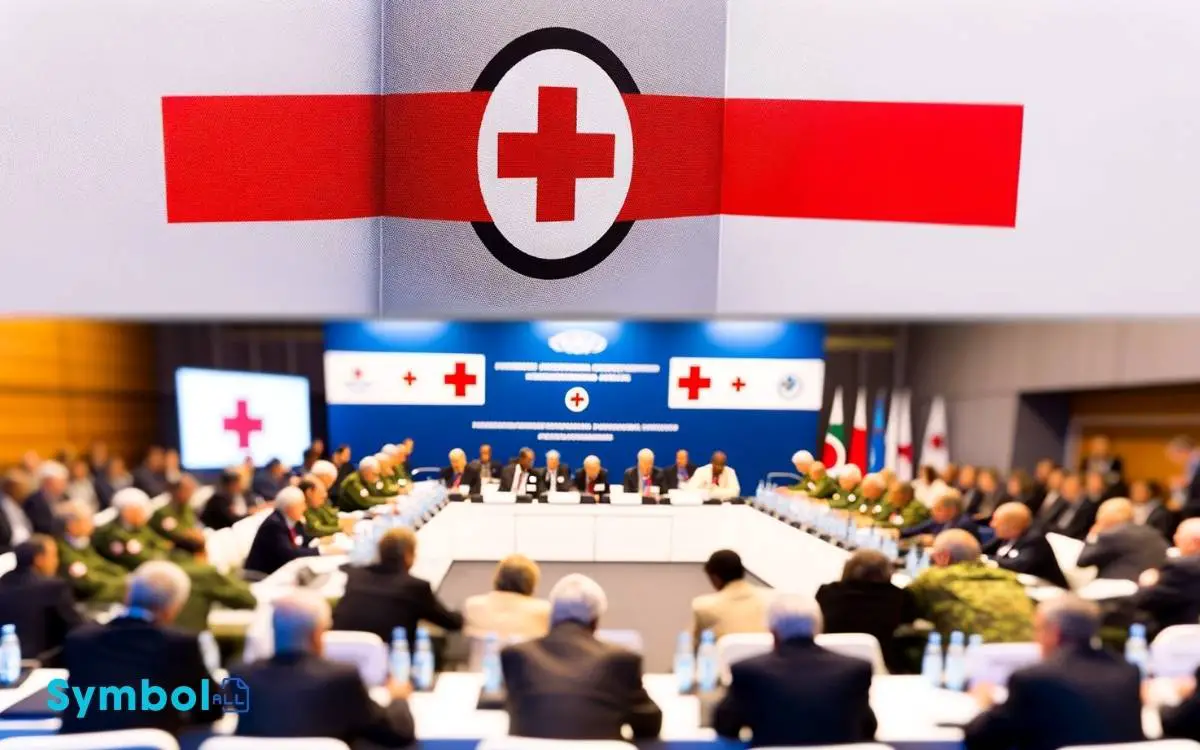Who Can Use Red Cross Symbol? Authorized Users!
You’re permitted to use the Red Cross symbol if you’re part of authorized entities like national societies implementing humanitarian missions, the international committee overseeing its application, or armed forces medical services in conflict zones.
Reserved strictly for those adhering to the Geneva Conventions, it symbolizes neutrality and protection, ensuring unambiguous humanitarian assistance.
Misusing this emblem not only leads to severe legal consequences, including fines and imprisonment, but also compromises global trust and the safety of aid workers.
Understanding and respecting its significant legal frameworks and protective power is crucial. There’s more on its impactful global recognition and operational significance.

Key Takeaways
Symbol Origins
The origin of the Red Cross symbol traces back to the 1864 Geneva Convention, where it was adopted as a protective emblem in wartime.
This symbol, a reverse of the Swiss flag, was chosen for its neutrality and universality, signifying impartial relief to the wounded on the battlefield.
It’s essential to grasp that its creation wasn’t arbitrary but a calculated decision to facilitate identification and protection under the law.
Its adoption marked a significant step towards the humanitarian effort, representing not just medical aid but also a commitment to the Geneva Conventions’ principles.
Understanding this emblem’s roots illuminates why it’s reserved for specific entities; it’s imbued with international significance, denoting sanctioned humanitarian aid.
This foundation underpins the symbol’s global recognition and respect, ensuring it remains a beacon of neutrality and assistance amidst conflict.
Legal Protections
Legal protections surrounding the Red Cross symbol are pivotal, ensuring that its use remains strictly regulated to safeguard its neutrality and significance in humanitarian efforts.
You must understand that these legal measures aren’t merely formalities but are essential to maintaining the integrity and trust associated with the symbol worldwide.
In numerous countries, the legislation clearly delineates who can display the Red Cross, typically restricting it to entities officially recognized and authorized to provide humanitarian aid.
Misuse or unauthorized representation not only undermines the symbol’s universal recognition but can also lead to legal repercussions, including fines and sanctions.
This strict regulatory framework ensures that when you see the Red Cross, it unequivocally signifies impartial and dedicated humanitarian assistance, unmarred by external affiliations or misinterpretations.
International Committee
Guiding the global humanitarian efforts, the International Committee of the Red Cross stands as a pivotal entity, ensuring the effective and impartial delivery of aid to those in need. It’s entrusted with the solemn responsibility to use and protect the Red Cross emblem.
Here’s why this matters:
- Legal Authority: The Committee has the international legal authority to sanction the use of the emblem during armed conflicts, safeguarding its perception as a symbol of neutrality and protection.
- Control Measures: It ensures that the emblem isn’t misused, preserving its integrity and the safety of those operating under its protection.
- Global Recognition: The emblem’s universal recognition relies on strict regulation by the Committee, ensuring that it remains a symbol of hope and assistance worldwide.
Understanding the Committee’s role is crucial for anyone delving into the humanitarian sector or the legal frameworks governing international relief operations.
National Societies
Operating across the globe, National Societies play a critical role in implementing the humanitarian missions of the Red Cross within their respective territories.
You’ll find these societies integral to the structure of the Red Cross, acting as primary agents in disaster response, health services, and emergency preparedness at the national level.
They’re authorized to use the Red Cross symbol, a privilege tightly regulated to prevent misuse and uphold the emblem’s neutrality and integrity.
To maintain this status, these societies adhere to rigorous guidelines, ensuring their operations align with the fundamental principles of the International Red Cross and Red Crescent Movement.
They’re bound by the Geneva Conventions, which dictate the emblem’s use, emphasizing its significance as a symbol of protection and neutrality in humanitarian efforts.
Armed Forces Medical Services
You must understand the critical role the Red Cross symbol plays within armed forces medical services, especially in conflict zones.
It’s imperative you’re aware of the strict regulations governing its usage to ensure compliance and respect for international protocols.
Analyzing its significance and adherence to these rules protects the integrity of medical services and ensures the safety of personnel.
Symbol Significance in Conflict
In armed conflicts, the Red Cross symbol serves a critical function, marking medical personnel and facilities as neutral parties and thereby affording them protection under international law. This emblem is a universal signal of neutrality and mustn’t be misused.
Here’s what it represents:
- Neutrality: It signifies that the bearer isn’t part of the conflict but is there to provide medical aid regardless of a soldier’s allegiance.
- Protection: It’s a protective shield under the Geneva Conventions, ensuring that those bearing or operating under the symbol are safeguarded against attacks.
- Humanitarian Assistance: It underscores a commitment to humanitarian values, prioritizing human life and dignity above all else.
Understanding this symbol’s significance helps you appreciate the sanctity of medical missions in tumultuous zones, ensuring respect and protection for those who endeavor to save lives amidst conflict.
Usage Regulations Compliance
Understanding the importance of the Red Cross symbol in conflict zones naturally leads to a discussion on how armed forces medical services must comply with its usage regulations to maintain the protection and neutrality it signifies.
You’ll find that the Geneva Conventions strictly govern this emblem’s use, granting it solely to medical personnel and facilities of the armed forces during warfare. This ensures that the symbol remains a marker of safety, signifying help that’s free from combatant involvement.
Misuse, such as displaying the Red Cross on combat vehicles or personnel, could undermine its universal recognition as a sign of humanitarian aid.
Consequently, adherence to these regulations isn’t just a matter of international law but a crucial step in safeguarding the sanctity of medical assistance in conflict zones.
Humanitarian Use Cases
The Red Cross symbol serves as a universal emblem of humanitarian aid, marking vehicles, personnel, and facilities engaged in relief efforts during conflicts and natural disasters. Its use is governed by strict regulations to ensure it remains a symbol of neutrality and protection.
Here’s a precise breakdown of its humanitarian use cases:
- Medical Services: It’s prominently displayed on ambulances and health facilities in conflict zones, signifying neutrality and offering protection under international law.
- Disaster Response: During natural disasters, it marks temporary shelters and relief personnel, facilitating safe and efficient aid delivery.
- Protection of Aid Workers: The emblem provides a layer of safety for volunteers and staff, deterring attacks and allowing unhindered access to affected areas.
These applications underscore the emblem’s critical role in global humanitarian efforts, safeguarding those who provide and receive aid.
Commercial Restrictions
Despite its widespread recognition as a humanitarian symbol, you can’t use the Red Cross emblem for commercial purposes due to strict international regulations.
These rules aim to preserve the symbol’s integrity, ensuring it remains a universally recognized sign of aid and neutrality.
The emblem’s use in any form of advertising, product branding, or corporate identity could mislead the public and dilute its significance.
Moreover, commercial entities attempting to associate their products or services with the Red Cross symbol risk infringing on protected rights, potentially facing legal ramifications.
It’s vital to understand that the emblem’s purpose is to signal impartial humanitarian assistance, not to endorse or promote commercial interests. Therefore, respecting these restrictions is crucial for maintaining the symbol’s respected status worldwide.
Misuse Penalties
You must understand that misusing the Red Cross symbol isn’t just unethical; it’s illegal and carries severe consequences. Legal actions can result in criminal or civil penalties, reinforcing the seriousness of such violations.
Additionally, financial repercussions, including hefty fines, can further compound the cost of non-compliance.
Legal Consequences
Misusing the Red Cross symbol can lead to significant legal consequences, including fines and imprisonment, under international and national laws.
When you disregard these regulations, you’re not only disrespecting a globally recognized emblem of aid and neutrality but also potentially hindering the operations of humanitarian organizations.
The legal ramifications are precise and severe to ensure the protection of this symbol’s integrity and the safety of those it represents.
Consider the following consequences:
- Criminal Charges: Depending on the jurisdiction, you could face criminal prosecution, leading to a criminal record.
- Fines: Monetary penalties can be substantial, reflecting the seriousness of the offense.
- Imprisonment: In severe cases, misuse may result in imprisonment, underscoring the legal system’s commitment to safeguarding the emblem.
Understanding these consequences is crucial for anyone considering using the Red Cross symbol.
Financial Repercussions
Facing financial repercussions for the misuse of the Red Cross symbol can significantly impact an individual’s or organization’s financial stability.
Misuse penalties aren’t trivial; they’re designed to deter unauthorized use and ensure respect for a symbol that signifies neutrality and protection under international law.
You could face hefty fines that vary depending on the jurisdiction but often amount to thousands of dollars. Beyond fines, you’re also looking at the potential cost of litigation.
If it comes to a lawsuit, you’re not just paying for your defense; you might end up compensating the Red Cross for damages, which could escalate your costs exponentially.
It’s a financial risk that’s unnecessary and avoidable if you adhere to the guidelines governing the symbol‘s use.
Educational Purposes
Although primarily recognized for its emblematic presence in humanitarian aid, the Red Cross symbol plays a crucial role in educational settings, where it serves as a powerful tool for teaching the principles of international humanitarian law and first aid.
In these environments, its usage is carefully regulated to ensure it maintains its significance and respect.
- Awareness: It raises awareness among students and educators about the critical importance of humanitarian efforts worldwide.
- Inspiration: It inspires a sense of duty and empathy, encouraging individuals to partake in voluntary services and to uphold humanitarian values.
- Knowledge: It serves as a beacon for learning essential life-saving skills, including first aid techniques, thus preparing individuals to act competently in emergencies.
Understanding its educational value underlines the necessity of respecting and protecting the symbol’s integrity, ensuring it remains a universal emblem of hope and assistance.
Disaster Response Operations
You must understand that the Red Cross symbol plays a critical role in disaster response operations, guiding the deployment criteria for intervention.
It’s essential to recognize how emergency aid coordination under this emblem ensures the efficient delivery of services and resources.
Furthermore, the symbol’s presence in volunteer training programs underscores the seriousness and commitment required for effective disaster response.
Red Cross Deployment Criteria
The criteria for Red Cross deployment in disaster response operations are meticulously outlined to ensure timely and effective assistance to affected communities.
The organization adheres to a set of standards that guide its actions, focusing on providing the most immediate and impactful support.
- Severity of the Disaster: The scale and impact of the event determine the urgency and extent of the response.
- Local Capacity to Respond: The existing local resources and ability to manage the disaster are assessed to understand where the Red Cross can fill gaps.
- Access and Security: Safe and unhindered access to the affected areas is crucial for delivering aid and protecting staff and volunteers.
These criteria ensure that aid is directed where it’s most needed, following a logical, evidence-based approach.
Emergency Aid Coordination
In disaster response operations, effective coordination of emergency aid is paramount to ensure resources are deployed where they’re most needed, avoiding duplication of efforts and maximizing the impact of the assistance provided.
This demands a highly structured approach to disaster management, incorporating real-time data analysis, logistics planning, and stakeholder communication.
You must understand that coordination involves not just the allocation of physical resources like food, water, and shelter, but also the deployment of specialized personnel.
Moreover, it’s critical to engage with local communities and authorities to tailor responses to specific needs and cultural contexts.
The Red Cross, with its emblematic symbol, plays a central role in orchestrating these efforts, ensuring that aid reaches its intended recipients swiftly and efficiently, thereby upholding the principles of humanity and impartiality.
Volunteer Training Programs
Volunteer training programs are essential for equipping individuals with the skills and knowledge required for effective disaster response operations. These programs are meticulously designed to prepare you for the complexities of disaster environments.
Analyzing the core components reveals:
- First Aid and Medical Training: You’ll acquire lifesaving skills, ranging from basic first aid to more advanced medical interventions, crucial for immediate disaster response.
- Logistics and Operations Management: Understanding the operational aspects, including resource management and coordination, ensures efficient deployment and utilization of assets.
- Psychological First Aid: Learning to address the emotional and mental well-being of victims is vital, ensuring a holistic approach to disaster response.
Protective Use in Conflict
Recognizing the Red Cross symbol’s protective role in conflict zones is essential for understanding its international significance.
This emblem serves as a shield, signaling to all parties in a conflict that the individuals or items it marks are neutral and must not be targeted.
The use of the Red Cross is strictly regulated under international law, ensuring that it remains a symbol of protection and assistance.
| Use Case | Legal Status |
|---|---|
| Medical Units | Protected |
| Humanitarian Aid | Protected under Geneva Convention |
| Armed Forces Vehicles | Not applicable |
You’re tasked with respecting these distinctions, ensuring the safety of aid workers and the effectiveness of humanitarian missions.
This emblem’s misuse compromises its integrity and endangers lives, highlighting the critical nature of adherence to its protective purpose in conflicts.
Licensing and Partnerships
Beyond its protective role in conflict zones, the Red Cross also engages in licensing and partnerships to extend its humanitarian reach and ensure the emblem’s respectful use.
Through these collaborations, it’s pivotal you grasp the structured approach towards the emblem’s application.
- Vetting Partners: The Red Cross meticulously selects partners that align with its values and missions, to maintain the symbol’s integrity.
- Licensing Agreements: These agreements clearly outline how the emblem can be used, ensuring it’s applied in a manner that respects its significance and aids in fundraising or awareness.
- Monitoring Use: Continuous oversight ensures the emblem isn’t misused or misrepresented, safeguarding its symbolic value and the organization’s reputation.
This strategic framework underscores the importance of controlled and respectful utilization of the Red Cross emblem in various collaborations, ensuring it remains a beacon of hope and aid worldwide.
Global Recognition
You must understand the Red Cross symbol‘s international significance; it’s a globally recognized emblem that signifies neutrality and protection in conflict zones.
Its universal protective power is enshrined in international law, ensuring it’s respected across all borders.
This recognition facilitates the organization’s humanitarian efforts worldwide, allowing for swift and unimpeded access to those in need.
Symbols International Significance
The Red Cross symbol garners global recognition, serving as a universal emblem of medical aid and humanitarian relief.
Its international significance can’t be overstated, as it:
- Represents neutrality and protection in conflict zones, ensuring aid workers and medical services aren’t targeted during armed conflicts.
- Symbolizes a commitment to humanitarian principles, rallying support and fostering trust across diverse cultures and political landscapes.
- Facilitates rapid response and coordination among international aid organizations during disasters and crises, streamlining efforts to provide relief and support to affected populations.
This emblem transcends language and cultural barriers, embodying a global pact to uphold human dignity and alleviate suffering wherever it may be found. Its universal acknowledgment is a testament to the collective human aspiration for peace and compassion.
Universal Protective Power
Globally recognized, the Red Cross symbol serves as a powerful shield, offering protection to those in dire need across every corner of the world. This universal emblem isn’t just a marker; it’s a beacon of hope, signifying neutrality and impartiality in humanitarian services.
Its presence demands respect and safe passage, safeguarding medical personnel, aid workers, and the victims of conflict or disaster.
You must understand, the emblem’s protective power is enshrined in international law, specifically the Geneva Conventions, which set out clear guidelines for its use.
Misuse not only undermines its integrity but can endanger lives by eroding the trust and safety the symbol represents.
Hence, its application is tightly controlled, ensuring its universal recognition remains untarnished, preserving its role as a protector in crises.
Recognition Across Borders
Across national boundaries, the Red Cross symbol garners universal recognition as a testament to humanitarian aid and protection. This emblem transcends cultural and linguistic barriers, serving as a beacon of neutrality and assistance in times of crisis.
You’ll find that its global recognition is built upon several key aspects:
- Legal Protection: Under international law, the emblem is protected, ensuring its unambiguous identification with humanitarian services.
- Universal Understanding: Regardless of language or literacy, the symbol communicates aid and safety.
- Consistency in Use: Uniform application across countries reinforces its identity and meaning.
This universal emblem operates under a framework of international agreements, ensuring its consistent and respectful use worldwide. It’s more than a symbol; it’s a global promise of help and protection, understood by millions regardless of where they are.
Reporting Misuse
Several instances of the Red Cross symbol’s misuse demand prompt reporting to maintain its integrity and effectiveness in humanitarian efforts. You’re essential in this process.
If you notice the emblem being used improperly whether on products, services, or within unauthorized organizations it’s your responsibility to act. This isn’t merely about adhering to regulations; it’s about preserving the symbol’s power to signify neutral and impartial aid.
When you report misuse, you’re contributing to a broader effort to ensure that, in times of crisis, the Red Cross emblem remains a beacon of hope and safety.
Your vigilance safeguards the symbol‘s sanctity, ensuring that its presence continues to command respect and provide protection universally.
Your actions fortify the global understanding and respect for humanitarian principles.
Conclusion
You’ve navigated the complex landscape of the Red Cross symbol, understanding its guarded origins, legal shields, and global embrace.
The emblem’s use is a privilege, reserved for those in the humanitarian vanguard and the guardians in military medical corps, ensuring it remains a beacon of hope.
As you’ve seen, stewardship and correct usage are vital, with any missteps gently corrected to maintain its integrity.
Remember, the symbol’s power lies in universal respect and meticulous guardianship, a testament to global solidarity in the face of adversity.




